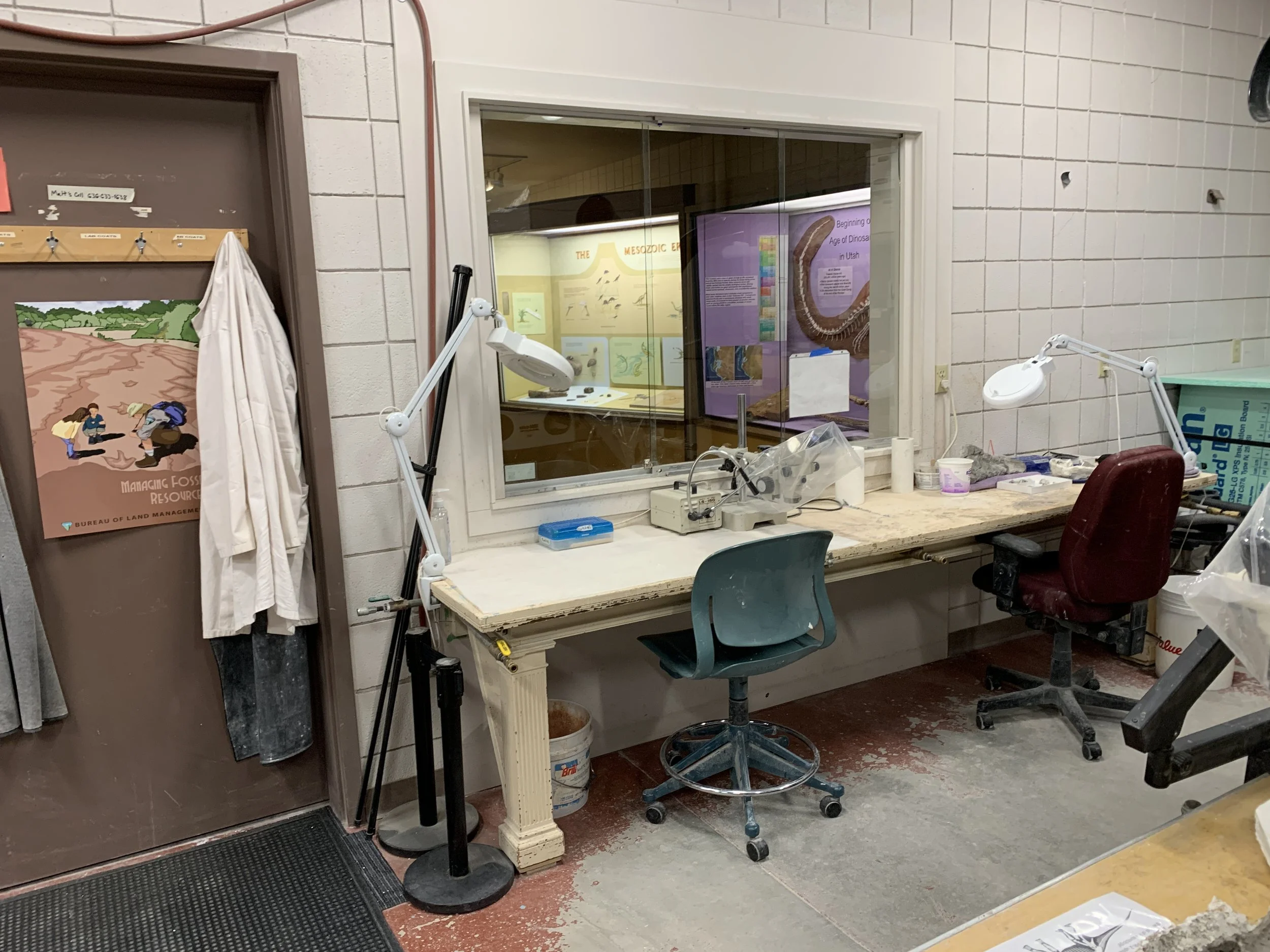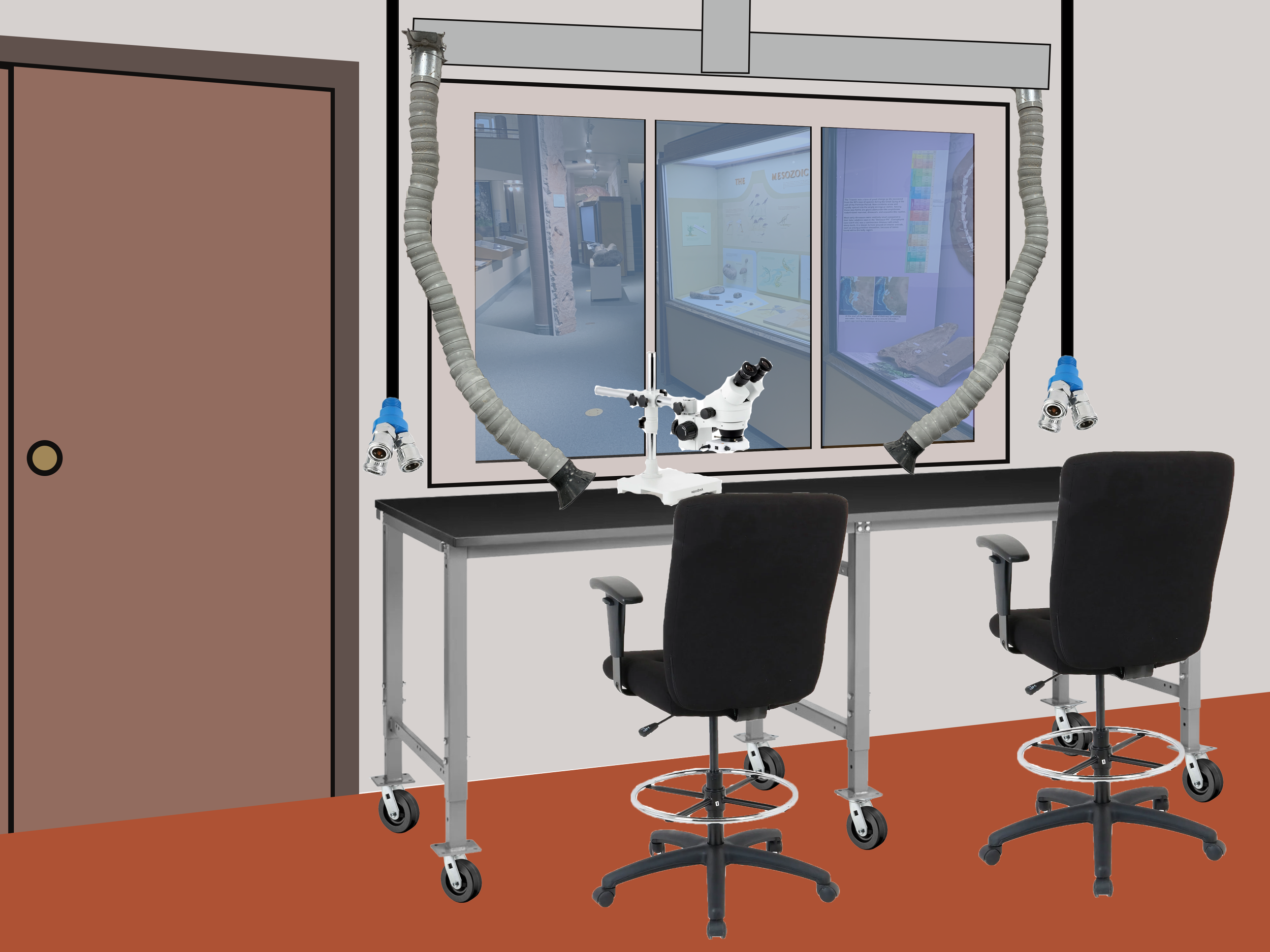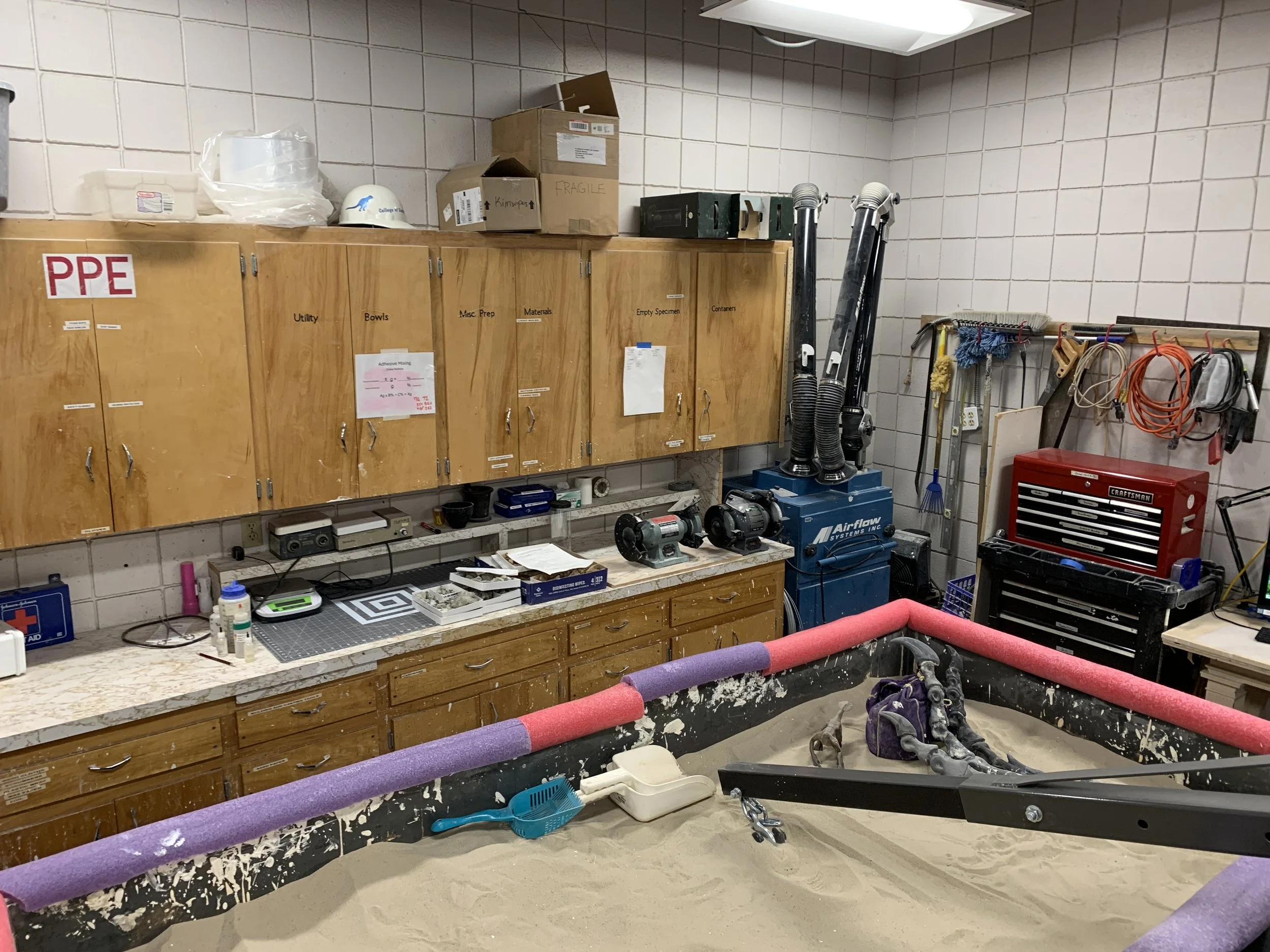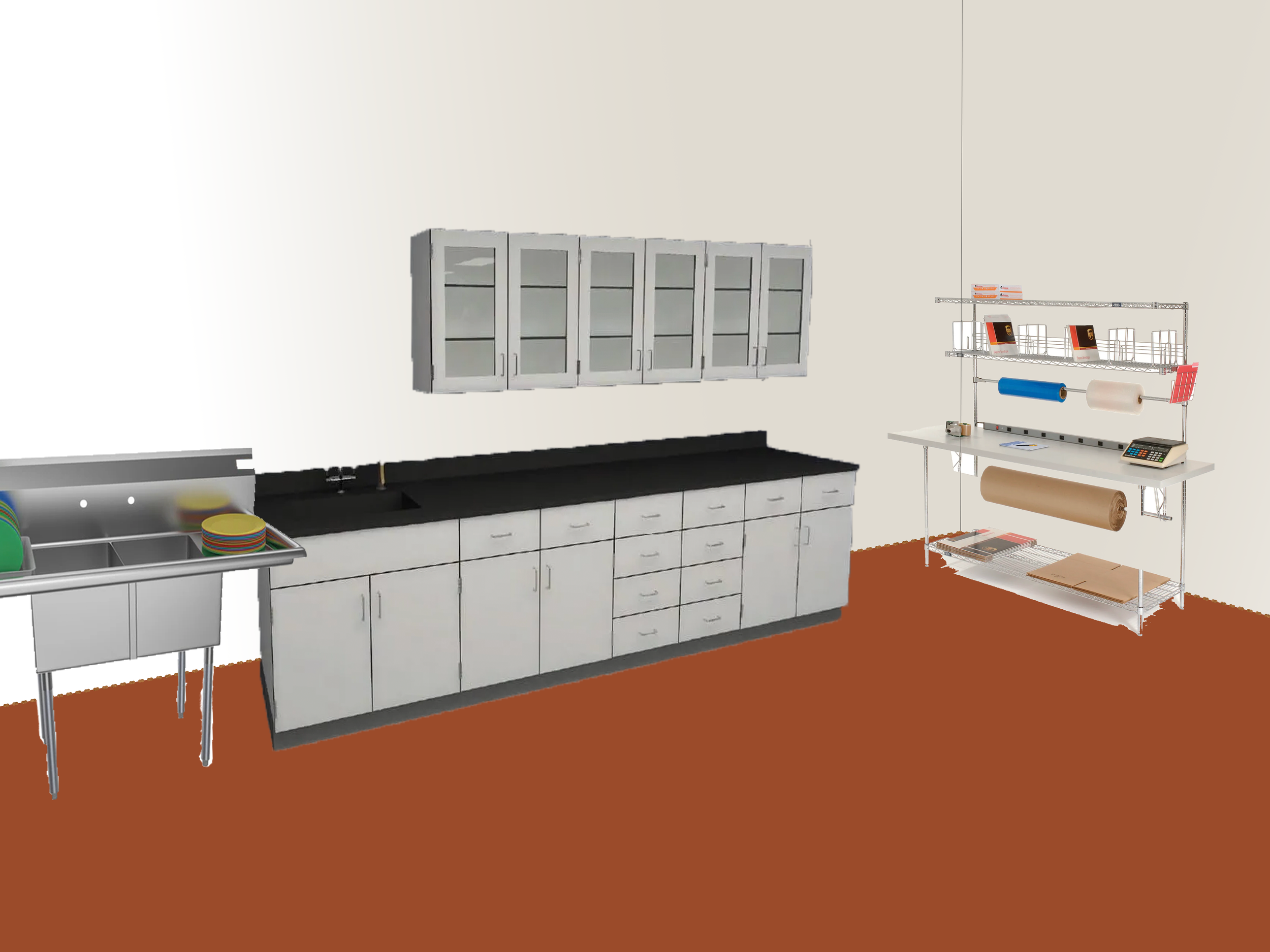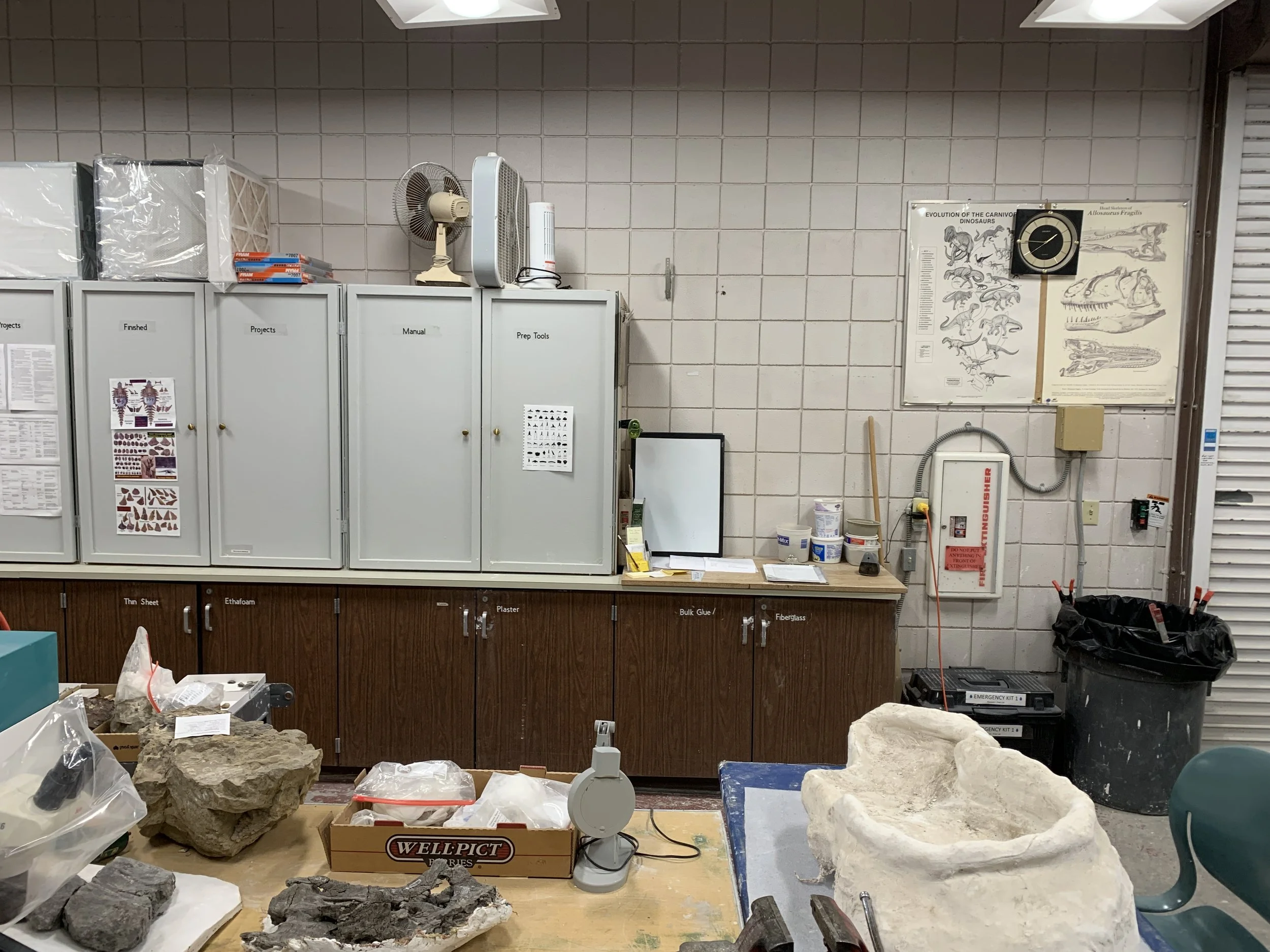Preserving the Past: Fossil Prep Lab Renovations at USU’s Prehistoric Museum
The original front wall of the Utah State University Eastern Prehistoric Museum's fossil prep lab. The lab will undergo renovations to maximize its footprint and upgrade its safety features. All images: Courtesy of Matthew Mers
Utah State University Eastern Prehistoric Museum in Price, UT is running a fundraising campaign to support renovations to its fossil preparation lab. This vital space is used by museum staff, students, and community volunteers to prepare fossils for exhibits, research, and preservation. Over its 60-year history, the lab has played a key role in naming eight new dinosaur species from eastern Utah and serves as a training ground for paleontology students from Utah State University and beyond. It even recently welcomed a volunteer from Carbon County 4-H. Popular among visitors, the lab offers a unique glimpse into “science in action.” However, the space lacks essential features found in modern fossil prep labs that would improve safety and maximize its limited footprint. Renovations are planned in three phases.
A mockup of the front wall area by Mers provides a clear roadmap for designing a lab space that meets user needs and aspirations.
Matthew Mers, paleontology lab and collections manager, discussed the renovation efforts with Lab Design News. He also shared mock-up images and floor plans illustrating how the lab staff plans to carry out the construction, contingent on the funding available.
Q: What prompted the Prehistoric Museum to launch this renovation plan and fundraising campaign for its fossil preparation lab?
A: Initially when I was joining the team, Dr. [Joshua] Lively, the curator of paleontology, was enthusiastic about improving the prep lab. He encouraged me to think of the lab as a blank slate and that is exactly what I did. Over the first few months I went about with standard fossil preparation work, and I tried to understand what was needed to modernize the lab. I then put together a proposal for the renovation. The cost of this renovation was unfortunately something this museum does not just have lying around. Dr. Lively heard that USU had a fundraising site, so he put together this fundraising campaign.
Q: How will the proposed renovations enhance the lab’s ability to prepare unique fossils, including those from newly named dinosaur species? How was lab user input collected when developing these renovation plans?
The original north wall area of the fossil prep lab.
A: While safety is a big focus of the renovation, another important aspect was better utilizing the space we have and making it more adaptable. The type of fossil material worked on in this lab is quite variable. Some of the tables are fixed in position and small while other locations lack appropriate air and electrical outlets. The renovation is going to improve this greatly, allowing us the flexibility to work on all types of material throughout the lab. New undescribed sauropod limbs will be able to be worked on in the front of the lab for the public to see while also allowing us to have the equipment we need right there rather than in a fixed location. I informally talked with the volunteers and students about what I thought, and they seemed extremely excited for the possible improvements.
Q: What safety upgrades are planned for the lab, and how will they impact both staff and visitors?
Mers’ plan for the updated north wall area.
A: Safety is the most important part. Dust and fumes are of the biggest concern when it comes to the long-term health of staff, students, and volunteers. Fossil preparation requires a lot of brushing and scraping but a tool that we use quite a bit produces a lot of dust. Air scribes are like mini jackhammers that help break up the rock that the fossils are incased in. In breaking up this sediment, a large volume of dust is produced that disseminates throughout the lab including the air. Continuous exposure to dust, particularly the dust that is composed of silica, can cause damage to the lungs known as silicosis. The rock material that we break up is primarily silica based. While we take measures to reduce exposure, improved dust extraction from the lab will help even more.
To fix and reconstruct the fossils we work on, we must glue pieces together. These adhesives produce fumes especially when we are making them. The adhesives we use have great properties for fossil preparation, but these adhesives use solvents that evaporate to cure. The fumes produced from the evaporation of these solvents can have long term health effects. By getting a fume hood, we can more safely prepare these adhesives while all of the fumes are exhausted outside. An additional technique we hope to implement in the future is acid prep which will digest the rock that encases the fossils. This process requires a fume hood for safe handling of these acids.
Today we have windows that look into the lab from the museum gallery, but these windows are glass panes that slide and do not seal. We are hoping to replace these with ones that fully seal. This will reduce dust and noise exposure for the guests of the museum. Other safety measures include adjustable tables for better ergonomics and retractable electric and air lines, so no cables drape the floor.
Floor plans designed by Mers to enhance the layout and safety features of the fossil prep lab.
Q: Can you describe how the current lab space falls short compared to modern fossil preparation facilities?
A: The current shortcomings of the lab are lab safety, flexibility of space, and equipment. Modern preparation labs that have the funding and large spaces to work which allows the space to be adjusted for material being worked on at that time. They have height adjustable mobile tables and ergonomic chairs. They have space for complex preparation such as histology, palynology, and CT processing. Space with equipment comparable to chemistry labs. They have large cranes that allow material to be safely moved within the space. They have extensive dust extraction throughout the space.
The original west wall area of the fossil prep lab.
Q: What makes the fossil preparation lab such a captivating feature for museum visitors, and how will the upgrades enhance this experience?
A: I think being able to watch fossil preparation helps guests to realize that prep is the bridge from field work to exhibit. They get to see the effort put into getting the fossils ready for display, and paleontology at work. Some will watch for quite some time while we painstakingly piece something together or remove sediment from the surface.
Q: What specific tools or technologies are prioritized for purchase in the three-phase renovation plan?
Plans for the upgraded west wall area.
A: The first phase has a focus on safety with the addition of dust extraction lines at workstations and new windows. This will cut down on the dust for the preparators but also the dust and noise for guests. Retractable air and electrical lines will be mounted in central spaces to minimize trip hazards.
Q: How will current research be affected once the renovations start? Do you have plans to halt research or move to a separate location?
A: The upgrades will have a minimal impact on research and preparation since we are doing it in phases. Research and preparation will be able to continue as normal, but some tools and equipment will be relocated elsewhere in the lab. This is one reason I chose a phased renovation over a complete renovation all at once.
Q: How do these renovations position the Prehistoric Museum to continue its legacy of groundbreaking paleontological discoveries?
A: While the significant paleontology discoveries would continue whether or not we performed the renovation, the update will allow us to work safer and more efficiently than before. I hope this will help give us more useable space in our existing footprint which I hope will allow us to get new and upgraded paleontology and preparation tools that will let up explore areas we have not yet been able to.
Joshua Lively, PhD, curator of paleontology at the Prehistoric Museum, also commented on the lab renovation fundraising efforts: “The Prehistoric Museum is the only accredited museum located in rural eastern Utah. The three main counties within our 9600 square mile geographic footprint have a combined population of just under 40,500. This gives us a much smaller local donor base when compared to museums on the Wasatch Front in Utah, which has major industry and a population of 2.6 million. With recent budget cuts going into effect from the State of Utah, we cannot petition for an increase on our state appropriated line item, which as it stands mostly covers staff salary.”

